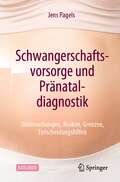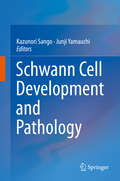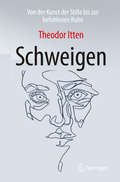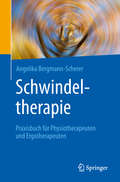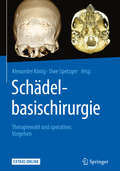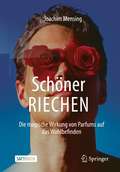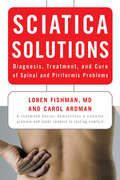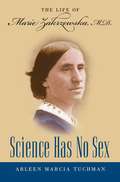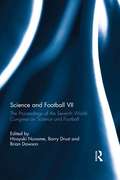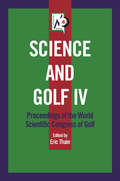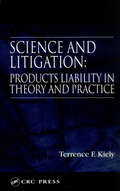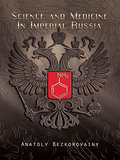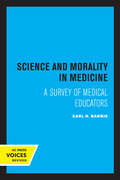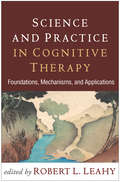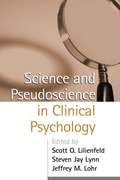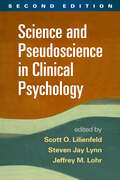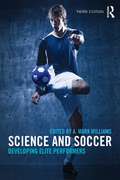- Table View
- List View
Schwangerschaftsabbruch und gestörte Frühschwangerschaft: Praxishandbuch mit Fallbeispielen
by Jana Maeffert Christiane TennhardtDies Buch ist als praktische Hilfe für Ärztinnen und Ärzte konzipiert, die Patientinnen mit ungewollter oder gestörter Frühschwangerschaft betreuen. Vorgestellt werden die verschiedenen Methoden der Behandlung. Um Kolleginnen das nötige Wissen an die Hand zu geben, vermitteln die Autorinnen theoretisches Wissen und vor allem praktisches Vorgehen. In bebilderten Fallbeschreibungen gehen sie auf Komplikationen und spezielle Situationen ein. Dabei werden die individuellen Lebensumstände der Patientin bei der Auswahl der Behandlungsmethode berücksichtigt. Die Therapie-Empfehlungen basieren auf Leitlinien internationaler Gesellschaften (RCOG, ACOG, FIGO, WHO) und der langjährigen Praxiserfahrung der Autorinnen.
Schwangerschaftsvorsorge und Pränataldiagnostik: Untersuchungen, Risiken, Grenzen, Entscheidungshilfen
by Jens PagelsMit dem positiven Schwangerschaftstest freut sich jede Frau auf ein gesundes Kind. Um Krankheiten oder Fehlbildungen frühzeitig zu erkennen und ggf. zu behandeln, gibt es heutzutage eine Vielzahl von Vorsorgeuntersuchungen: vom Ultraschall und der Bestimmung von Blutwerten oder einer genetischen Untersuchung, über die Chorionzottenbiopsie bis hin zur Behandlung des ungeborenen Kindes im Mutterleib. In diesem Ratgeber erklärt der erfahrene Frauenarzt allgemeinverständlich die verschiedenen Verfahren und gibt Antworten auf Fragen wie: Zu welchem Zeitpunkt und wie wird die Untersuchung durchgeführt? Welche Risiken birgt die Untersuchung für Mutter und Kind und was bedeuten die Ergebnisse? Auch auf die Themen Risikoschwangerschaft und Schwangerschaftsabbruch geht der Autor ein und thematisiert, ob alles sinnvoll, was medizinisch möglich ist. Kommentare aus ethischer Sicht erweitern den Blickwinkel auf sensible Themen. Plus: Formulare, hilfreiche Adressen von Beratungsstellen, Selbsthilfegruppen und ein Glossar medizinischer Fachbegriffe.Ein hilfreicher Ratgeber für schwangere Frauen, werdende Eltern und andere interessierte Leser.
Schwann Cell Development and Pathology
by Kazunori Sango Junji YamauchiThis book presents recent topics on the development, differentiation, and myelination of Schwann cells, as well as pathological mechanisms and therapeutic approaches for peripheral neuropathies, such as Charcot-Marie-Tooth diseases, amyloid polyneuropathy, immune-mediated neuropathy and diabetic neuropathy. The rapid progress of molecular biological techniques in the last decades, especially for RNA techniques and gene modification technologies have allowed us to investigate the pathobiology of Schwann cells in vivo and in vitro. Studies combining recent stem cell biology with recent biotechnology, which is now closely linked to physicochemical fields, further explain how Schwann cell lineages develop a process that has long been thought to be very complicated in vivo. The findings contribute to the elucidation of fundamental mechanisms during development and under pathological conditions. We now know that these are closely tied to each other. This book also introduces unique coculture systems to reproduce the neuron-Schwann cell interplay during development, degeneration, and regeneration. Up-to-date research topics with high-quality immunofluorescence and electron micrographs introduced by young and energetic contributors are sure to arouse the readers' interest in Schwann cell biology. Discussion from the viewpoint of basic and clinical neuroscience makes the book educational for researchers, medical students and young clinicians.
Schwann Cells: Methods And Protocols (Methods In Molecular Biology #1739)
by Paula V. Monje Haesun A. KimThis volume presents an assortment of traditional and emerging experimental procedures relevant to Schwann cell research. The chapters are divided into four parts. Part I contains protocols for in vitro culture, purification, and characterization of primary Schwann cells from diverse species and stages of nerve development. It also contains protocols to create cancer cell lines and engineered Schwann cells from unconventional sources via chemical conversion, induced differentiation or genetic intervention. Parts II and III outline a wide range of methodologies used to study Schwann cells within in vitro and in vivo systems relevant to the analysis of peripheral nerve development, cancer, axon degeneration/regeneration, and myelination. Last but not least, part IV outlines protocols for Schwann cell production, collection, labeling and transplantation in the injured peripheral nerve and spinal cord of experimental animals and human subjects. Authoritative and practical, Schwann Cells: Methods and Protocols aims to aid both experienced and new investigators to make progress in their research endeavors involving Schwann cells.
Schweigen: Von der Kunst der Stille bis zur befohlenen Ruhe
by Theodor IttenStille und Schweigen sind im Alltag und in der Politik ständig präsent, aber warum sprechen wir so selten darüber? Wir lieben die Stille, die Ruhe, wenn wir sie brauchen, halten sie aber kaum aus, wenn wir ihr Gegenüber sind. Im Geheimnis verschweigen wir etwas, das uns beschützt und hilft zu leben. Auf der anderen Seite wird manches buchstäblich totgeschwiegen, das zur Sprache gebracht werden müsste, um Heilung zu ermöglichen. Untertanen werden mit diktatorischem Gehabe zum Schweigen gebracht – eine kommunikative Machtdemonstration.Dieses Buch beschreibt und analysiert aus sozialpsychologischer, kulturhistorischer und philosophischer Perspektive das menschliche Verhalten im Bezug zur Stille. Eindrucksvoll bringt der Autor zu Wort, was seine Erfahrungen, Gedanken, Textforschungen und Expertengespräche rund um dieses vielschichtige Thema hergeben, und lässt so neue, überraschende Verbindungen zwischen Stille, Schweigen und Ruhegeben entstehen. Ein erzählender Wegweiser mit nachdenklich stimmenden und amüsanten Erkenntnissen für alle Menschen, die dem Schweigen in all seinen Aspekten auf den Grund gehen möchten.
Schwindeltherapie: Praxisbuch für Physiotherapeuten und Ergotherapeuten
by Angelika Bergmann-SchererDrehen, schwanken, taumeln – so unterschiedlich wie die Beschreibungen von Patienten, so unterschiedlich sind auch die möglichen Ursachen und Behandlungsansätze bei Schwindel. Was aber sind mögliche Ursachen? Wie sieht eine spezifische Befunderhebung aus? Und wie eine erfolgversprechende Schwindeltherapie? Antworten auf diese Fragen finden Physio- und Ergotherapeuten in diesem Buch.Die Autorin verknüpft theoretische Grundlagen zu verschiedenen Schwindelformen mit einer praxisnahen Darstellung von der Befundaufnahme bis zur Behandlung. Über 100 Abbildungen helfen dem Leser, die Inhalte unkompliziert in den Arbeitsalltag zu übernehmen. Inhalt Ursachen, Symptome und Verlauf unterschiedlicher Schwindelformen, inklusive Morbus Menière, benignem paroxysmalen Lagerungsschwindel, Labyrinthitis, zentralem, occulärem und HWS- bedingtem Schwindel Tests und Assessments für eine spezifische Befunderhebung und Therapieplanung Nach Krankheitsbildern gegliederte Behandlungsansätze Werden Sie zum Schwindel-Experten und ermöglichen Sie Ihren Patienten einen optimalen Behandlungserfolg!
Schädelbasischirurgie
by Uwe Spetzger Alexander KönigDie Behandlungsprinzipien und das operative Vorgehen des Neurochirurgen bei Erkrankungen und Verletzungen der Schädelbasis sind in praxisorientierter, reich illustrierter Form in diesem Buch beschrieben. Dazu haben internationale Spezialisten ihr Expertenwissen beigetragen und geben präzise Empfehlungen zur Therapiewahl und zur Auswahl des chirurgischen Verfahrens bei den einzelnen Indikationen. Ausgewählte offene und endoskopische Techniken werden durch Bildserien und Fallbeispiele und teilweise durch Operationsvideos veranschaulicht. Die Beschreibung der klinischen Anatomie der Region und der chirurgischen und strahlentherapeutischen Behandlungsprinzipien runden die Darstellung ab.
Schöner RIECHEN: Die magische Wirkung von Parfums auf das Wohlbefinden
by Joachim MensingDieses Buch macht Sie zum Parfum Insider. Entdecken Sie Wirkung, Trends und Zukunft von Parfums. Die Parfümerie steht aufgrund neuer Methoden der Gehirnforschung und aktueller Erkenntnisse der Duftpsychologie kurz vor ihrer dritten Revolution, der Neuroparfümerie. Mit diesem spannend und fundiert geschriebenen Buch gewinnen Sie einen umfassenden Einblick in die Kreation, Welt und Praxis der modernen Parfümerie und erhalten dazu interessante Insiderinformationen. Aktuelle Erkenntnisse der Psychologie, Aromatherapie, Gehirnforschung und Neuroparfümerie zur Wirkung von Düften machen Schöner RIECHEN zur Fundgrube von neuen Erkenntnissen. Als Sachbuch mit Ratgeberanteil ist es ohne Vorkenntnisse leicht lesbar und gibt viele praktische Tipps. Sie erfahren unter anderem, dass einige Parfums bereits weit mehr können, als nur gut zu riechen, wie Parfümeure und Marketing ihre Parfums kreieren, welche Duftvorlieben vorherrschen und wie durch Duftwirkung das eigene Erleben und die Lebensfreude gezielt beeinflusst werden kann. Zielgruppen Alle, die Parfums und Düfte lieben und mehr über die magische Wirkung von Parfums auf das Wohlbefinden erfahren möchten und vielleicht mit dem Gedanken spielen, einmal selbst ihr eigenes Parfum zu kreieren. Es ist auch ideal für diejenigen, die in der Duft-, Kosmetik- und Beautybranche tätig sind und ihr Wissen rund um Parfums auffrischen möchten. Zum Autor Dr. Joachim Mensing ist Dipl.-Psychologe, Soziologe, und trainierte Nase mit über 30 Jahren Berufspraxis in der Parfümerie und Dufttherapie. Bei einem der größten Dufthersteller wurde er zum Trend-Coach der Parfümeure und entwickelte Methoden der Parfumentwicklung und des Marketings. Viele der Parfums, an denen er arbeitete, erhielten begehrte Auszeichnungen wie den Fifi-Award, den Oscar für Parfums.
Sciatica Solutions: Diagnosis, Treatment, and Cure of Spinal and Piriformis Problems
by Loren Fishman Carol ArdmanA world-renowned clinician's practical and complete guide to understanding and alleviating neurological pain in the lower back, buttocks, and legs. Sciatica is the feeling of pain, numbness, "electric shocks," or strange sensations in the seat and running down the leg. It will afflict some five million Americans this year. In easy-to-understand terms, Loren Fishman demystifies the relationship between neurological injury and sciatica, explains the most common causes, leads readers to an exact diagnosis, and outlines the options available for lasting comfort and cure.
Sciatica and Chronic Pain: Past, Present and Future
by Robert W. BalohThis highly engaging title offers a concise, state-of-the-art overview of the management of sciatica and chronic pain. Written by a well-known neurologist, the book explores the multifaceted approach to the management of sciatica and chronic pain from many viewpoints, including the pharmacologic and surgical, as well as less orthodox methods. In discussing the many different aspects of pain – including neural networks, neural transmitters and genetic viewpoints – the book also provides a thorough review of how various factors interact to make us perceive pain. Importantly, the neuroscience and medical jargon that goes with the field is minimized by the author by defining terms as they are introduced and providing a glossary with definitions of key terms. Contributing to the unique nature of this highly instructive book, three patients with sciatica and chronic pain are followed serially throughout the text to illustrate important concepts that are discussed. A wide range of charts, figures and tables help clarify new concepts as well. Practical and illustrative, Sciatica and Chronic Pain: Past, Present and Future will be of great interest to a wide audience, including medical trainees and practicing physicians at all stages of their careers. Patients may find the book of significant value as well.
Science Has No Sex
by Arleen Marcia TuchmanGerman-born Marie Zakrzewska (1829-1902) was one of the most prominent female physicians of nineteenth-century America. Best known for creating a modern hospital and medical education program for women, Zakrzewska battled against the gendering of science and the restrictive definitions of her sex. In Science Has No Sex, Arleen Tuchman examines the life and work of a woman who continues to challenge historians of gender to this day. At a time when most women physicians laid claim to "female" qualities of care and nurturance to justify their professional choice, Zakrzewska insisted that all physicians, regardless of gender, should depend upon the rational faculties developed through training in the natural sciences. She viewed science as a democratizing tool--anyone could master science, she asserted, and therefore the doors to the elite profession of medicine should be opened to all.Shedding light on the changes that radically transformed medicine in the late nineteenth century, Tuchman's analysis also demonstrates how Zakrzewska's activism is important to the ongoing debate over the relationship between science and sex.
Science and Football VII: The Proceedings of the Seventh World Congress on Science and Football
by Brian Dawson Hiroyuki Nunome Barry DrustScience and Football VII showcases the very latest scientific research into the variety of sports known as ‘football’. These include soccer, the national codes (American football, Australian rules football and Gaelic football), and the rugby codes (union and league). Bridging the gap between theory and practice, this book is by far the most comprehensive collection of current research into football, presenting important new work in key areas such as: physiology of training performance analysis fitness assessment nutrition biomechanics injury and rehabilitation youth football environmental physiology psychology in football. Science and Football VII is an essential resource for all sport scientists, trainers, coaches, physical therapists, physicians, psychologists, educational officers and professionals working across the football codes. The papers contained within this volume were first presented at the Seventh World Congress on Science and Football, held in May 2011 in Nagoya, Japan. The meeting was held under the auspices of the International Steering Group on Science and Football, a representative member of the World Commission of Science and Sports.
Science and Golf IV
by Eric ThainThe fourth World Scientific Congress of Golf, to be held in St Andrews in July 2002, will bring together all of the world's leading golf researchers. Science and Golf IV will present 90 or so of the best research papers delivered at the Congress, and represents the latest volume in a unique and essential series of scientific studies in golf. The book is organised into four thematic sections, looking at the golfer, golf equipment, the golf course, and the social and economic impact of golf respectively, and addresses key topics such as: * the psychology of golf * biometrics of the swing * new developments in clubs, balls and teaching aids * golf agronomy, irrigation and drainage * the impact of golf on the community * representing the most up-to-date collection of research available. Science and Golf IV is essential reading for all sport scientists and researchers with an interest in golf, all club professionals, and all those working in technical aspects of the golf industry.
Science and Litigation: Products Liability in Theory and Practice
by Terrence F. KielyThe question "what is science" has been one of the most vigorously contested legal questions as to what is legally acceptable scientific foundation for the submission of expert opinion in a wide variety of cases, especially in products liability cases. The answer usually lies in the outcomes of past cases as well as objective scientific literature.
Science and Medicine in Imperial Russia
by Anatoly BezkorovainyThe author’s intention to write “Science and Medicine in Imperial Russia” was to acquaint the American medical and scientific professionals, and, hopefully, the general public, with the accomplishments of Russian scientists and physicians in the areas of their professions. The authors has limited his story to medicine, chemistry, and biology, the areas of his extended experience. American public’s thinking, due to a number of reasons, is that Imperial Russia was a “swamp” (to use President Trump’s expression), in which nothing of medical or scientific importance has ever been discovered or developed. This author, of course, thinks otherwise, and presents in this volume an ample amount of evidence to show that in the fields listed above, the accomplishments of the Russians were surprisingly numerous. As an example, one can cite the discoveries of Russian organic chemists (especially at the Kazan University), which, arguably, were exceeded only by the Germans. The problem in Russia was the lack of funds to put the basic science discoveries to practical use. As an example, one can mention the discovery of the aniline synthesis method by Zinin, a professor at Kazan University. Aniline became the basis for the synthesis of modern dyes, immediately picked by Western European nations, but not by the Russians. And such lists of accomplishments without putting them into practical use were many. This book provides descriptions of Russia’s discoveries, largely using original scientific and medical publications written by its scientists and physicians of Russia in Russian -lunguage journals, of which there were many, or, for the most part, in German publications. The Russians published largely in German, and less so in French journals in order to have a broader audience. Few foreigners knew the Russian language, but all knew German and/or French.
Science and Morality in Medicine: A Survey of Medical Educators
by Earl R. BabbieThis title is part of UC Press's Voices Revived program, which commemorates University of California Press’s mission to seek out and cultivate the brightest minds and give them voice, reach, and impact. Drawing on a backlist dating to 1893, Voices Revived makes high-quality, peer-reviewed scholarship accessible once again using print-on-demand technology. This title was originally published in 1970.
Science and Practice for Heated Tobacco Products: Japan as a Test Bed for Novel Tobacco Products
by Takahiro TabuchiThe main focus of this book is providing evidence on and interpreting the risks associated with heated tobacco products (HTPs) in terms of their health effects and social effects; in addition, the author introduces a harm reduction theory related to HTPs and electronic cigarettes. The book also addresses the history of these products, their marketing strategies, and policy implications. These products are new and the accompanying health risks have yet to be determined. However, since Japan accounts for more than 80% of the world’s market for IQOS, the most popular heated tobacco product, researchers around the globe will be very interested in the outcomes. Written by a leading researcher in the field of tobacco control, Science and Practice for Heated Tobacco Products offers a valuable, unique resource for researchers in the fields of epidemiology, public health, social sciences, addiction, and tobacco research. Since tobacco is associated with a host of diseases including cancers, cardiovascular diseases, diabetes mellitus, and respiratory illnesses, researchers and healthcare workers whose work involves these diseases will find this book both thought provoking and insightful.
Science and Practice in Cognitive Therapy: Foundations, Mechanisms, and Applications
by Robert L. LeahyFrom leading experts in cognitive-behavioral therapy (CBT)--including CBT originator Aaron T. Beck and many who have worked closely with him--this book provides an overview of where the field is today and presents cutting-edge research and clinical applications. Contributors explain how Beck's cognitive model has been refined and tested over the last 45 years and describe innovative CBT approaches that integrate mindfulness, imagery, emotion-focused interventions, and other strategies. Chapters on specific clinical problems cover the conceptualization and treatment of depression, anxiety disorders, posttraumatic stress disorder, obsessive–compulsive disorder, insomnia, suicidality, substance abuse, couple and family problems, bipolar disorder, psychosis, and personality disorders.
Science and Practice of Pressure Ulcer Management
by Michael Clark Marco Romanelli Amit Gefen Guido CiprandiOnly comprehensive reference book on pressure ulcers and their management Only book in its field endorsed by the European Pressure Ulcer Advisory Panel, the leading European authority on pressure ulcers
Science and Pseudoscience in Clinical Psychology
by Scott LilienfeldThis book offers a rigorous examination of a variety of therapeutic, assessment, and diagnostic techniques in clinical psychology, focusing on practices that are popular and influential but lack a solid grounding in empirical research. Featuring chapters from leading clinical researchers, the text helps professionals and students evaluate the merits of novel and controversial techniques and differentiate between those that can stand up to scientific scrutiny and those that cannot. Reviewed are widely used therapies for alcoholism, infantile autism, and ADHD; the use of EMDR in the treatment of posttraumatic stress disorder; herbal remedies for depression and anxiety; suggestive techniques for memory recovery; and self-help models. Other topics covered include issues surrounding psychological expert testimony, the uses and abuses of projective assessment techniques, and unanswered questions about dissociative identity disorder. Offering a balanced, constructive review of available research, each accessibly written chapter concludes with a glossary of key terms.
Science and Pseudoscience in Clinical Psychology, Second Edition
by Carol Tavris Scott O. Lilienfeld Steven Jay Lynn Jeffrey M. LohrThis valued resource helps practitioners and students evaluate the merits of popular yet controversial practices in clinical psychology and allied fields, and base treatment decisions on the best available research. Leading authorities review widely used therapies for a range of child, adolescent, and adult disorders, differentiating between those that can stand up to the rigors of science and those that cannot. Questionable assessment and diagnostic techniques and self-help models are also examined. The volume provides essential skills for thinking critically as a practitioner, evaluating the validity of scientific claims, and steering clear of treatments that are ineffective or even harmful. New to This Edition *Reflects the significant growth of evidence-based practices in the last decade. *Updated throughout with the latest treatment research. *Chapter on attachment therapy. *Chapter on controversial interventions for child and adolescent antisocial behavior. *Addresses changes in DSM-5.
Science and Religion: A Historical Introduction
by Gary B. FerngrenAn essential examination of the historical relationship between science and religion.Since its publication in 2002, Science and Religion has proven to be a widely admired survey of the complex relationship of Western religious traditions to science from the beginning of the Christian era to the late twentieth century. In the second edition, eleven new essays expand the scope and enhance the analysis of this enduringly popular book.Tracing the rise of science from its birth in the medieval West through the scientific revolution, the contributors here assess historical changes in scientific understanding brought about by transformations in physics, anthropology, and the neurosciences and major shifts marked by the discoveries of Copernicus, Galileo, Isaac Newton, Charles Darwin, and others. In seeking to appreciate the intersection of scientific discovery and the responses of religious groups, contributors also explore the theological implications of contemporary science and evaluate approaches such as the Bible in science and the modern synthesis in evolution, which are at the center of debates in the historiography, understanding, and application of science.The second edition provides chapters that have been revised to reflect current scholarship along with new chapters that bring fresh perspectives on a diverse range of topics, including new scientific approaches and disciplines and non-Christian traditions such as Judaism, Islam, Asiatic religions, and atheism. This indispensible classroom guide is now more useful than ever before.Contributors: Richard J. Blackwell, Peter J. Bowler, John Hedley Brooke, Glen M. Cooper, Edward B. Davis, Alnoor Dhanani, Diarmid A. Finnegan, Noah Efron, Owen Gingerich, Edward Grant, Steven J. Harris, Matthew S. Hedstrom, John Henry, Peter M. Hess, Edward J. Larsen, Timothy Larson, David C. Lindberg, David N. Livingstone, Craig Martin, Craig Sean McConnell, James Moore, Joshua M. Moritz, Mark A. Noll, Ronald L. Numbers, Richard Olson, Christopher M. Rios, Nicolaas A. Rupke, Michael H. Shank, Stephen David Snobelen, John Stenhouse, Peter J. Susalla, Mariusz Tabaczek, Alan C. Weissenbacher, Stephen P. Weldon, and Tomoko Yoshida
Science and Soccer: Developing Elite Performers
by A. Mark Williams Barry Drust Paul R. FordNow in a fully revised and updated fourth edition, Science and Soccer is still the most comprehensive and accessible introduction to the physiology, biomechanics and psychology behind the world's most popular sport. Offering important guidance on how science translates into practice, the book examines every key facet of the sport, with a particular focus on the development of expert performers. The topics covered include: • anatomy, physiology, psychology; sociology and biomechanics; • principles of training; • nutrition; • physical and mental preparation; • playing surfaces and equipment; injury • decision-making and skill acquisition; • coaching and coach education; • performance analysis; • talent identification and youth development. Science and Soccer: Developing Elite Performers is a unique resource for students and academics working in sports science. It is essential reading for all professional support staff working in the game, including coaches at all levels, physiotherapists, conditioning specialists, performance analysts, club doctors and sport psychologists.
Science and Soccer: Developing Elite Performers
by Mark A. WilliamsNow in a fully revised and updated third edition, Science and Soccer is still the most comprehensive and accessible introduction to the physiology, biomechanics and psychology behind the world's most popular sport. Offering important guidance on how science translates into practice, the book examines every key facet of the sport, with a particular focus on the development of elite performers. The topics covered include: anatomy, physiology, psychology and biomechanics; principles of training; nutrition; physical and mental preparation; playing surfaces and equipment; decision-making and skill acquisition; coaching and coach education; performance analysis; talent identification and youth development. Science and Soccer: Developing Elite Performers is a unique resource for students and academics working in sports science. It is essential reading for all professional support staff working in the game, including coaches at all levels, physiotherapists, conditioning specialists, performance analysts, club doctors and sport psychologists.
Science as Autobiography: The Troubled Life of Niels Jerne
by Thomas Soderqvist Niels Kaj Jerne David Mel PaulThis biography probes the unusual mind, the dramatic life, and the outstanding scientific work of Danish-born immunologist Niels Jerne (1911-1994). Jerne's Nobel Prize-winning achievements in the field of immunology place him in the pantheon of great twentieth-century biomedical theorists, yet his life is perhaps even more interesting than his science. Science as Autobiography tells Jerne's story, weaving together a narrative of his experiences, emotional life, and scientific work, and arguing that the source of Jerne's extraordinary creativity as a scientist rested in his life story. Drawing on Jerne's own extensive archives, on more than 150 hours of conversation with him, and on the recollections of over 90 friends, colleagues, and relatives, Thomas Soderqvist explores the myths and legends about Jerne - his unparalleled powers of concentration and analytical keenness, his preference for conversation in a Paris cafe over work in the laboratory, his problematic personal life, Soderqvist punctuates the book with Jerne's own voice and makes the argument that Jerne's life experience and view of himself became a metaphorical resource for the construction of his theories. The author also probes the moral issues that surrounded Jerne's choice to sacrifice the welfare of his family in favor of scientific goals and the pursuit of excellence. --BOOK JACKET. Title Summary field provided by Blackwell North America, Inc. All Rights Reserved

